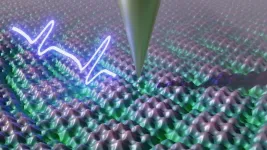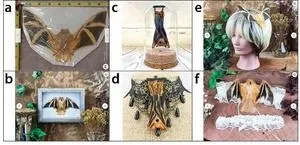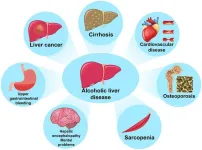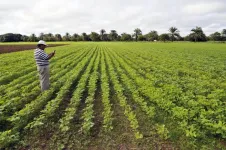(Press-News.org) "With the method we developed, we can make things visible that no one has seen before," says Prof. Sebastian Loth, Managing Director of the Institute for Functional Matter and Quantum Technologies (FMQ) at the University of Stuttgart. "This makes it possible to settle questions about the movement of electrons in solids that have been unanswered since the 1980s." However, the findings of Loth's group are also of very practical significance for the development of new materials.
Tiny changes with macroscopic consequences
In metals, insulators, and semiconductors, the physical world is simple. If you change a few atoms at the atomic level, the macroscopic properties remain unchanged. For example, metals modified in this way are still electrically conductive, whereas insulators are not. However, the situation is different in more advanced materials, which can only be produced in the laboratory: Minimal changes at the atomic level cause new macroscopic behavior. For example, some of these materials suddenly change from insulators to superconductors, i.e. they conduct electricity without heat loss. These changes can happen extremely quickly, within picoseconds, as they influence the movement of electrons through the material directly at the atomic scale. A picosecond is extremely short, just a trillionth of a second. It is in the same proportion to the blink of an eye as the blink of an eye is to a period of over 3000 years.
Recording the movement of the electron collective
Loth's working group has now found a way to observe the behavior of these materials during such small changes at the atomic level. Specifically, the scientists studied a material consisting of the elements niobium and selenium in which one effect can be observed in a relatively undisturbed manner: the collective motion of electrons in a charge density wave. Loth and his team investigated how a single impurity can stop this collective movement. For this purpose, the Stuttgart researchers apply an extremely short electrical pulse, which lasts just one picosecond, to the material. The charge density wave is pressed against the impurity and sends nanometer-sized distortions into the electron collective, which cause highly complex electron motion in the material for a short time. Important preliminary work for the results now presented was done at the Max Planck Institute for Solid State Research (MPI FKF) in Stuttgart and at the Max Planck Institute for the Structure and Dynamics of Matter (MPSD) in Hamburg, where Loth had been conducting research before he was appointed to the University of Stuttgart.
Developing materials with desired properties
"If we can understand how the movement of the electron collective is stopped, then we can also develop materials with desired properties in a more targeted manner," Loth explains the potential of the results. Or to put it another way: As there are no perfect materials without impurities, the microscopy method developed helps to understand how impurities should be arranged in order to achieve the desired technical effect. "Design at the atomic level has a direct impact on the macroscopic properties of the material," says Loth, describing the significance of the research findings. The effect could be used, for example, for ultra-fast switching materials in future sensors or electronic components.
An experiment repeated 41 million times per second
"There are established methods for visualizing individual atoms or their movements," explains Loth. "But with these methods, you can either achieve a high spatial resolution or a high temporal resolution." For the new Stuttgart microscope to achieve both, the physicist and his team combine a scanning tunneling microscope, which resolves materials at the atomic level, with an ultrafast spectroscopy method known as pump-probe spectroscopy.
In order to make the necessary measurements, the laboratory setup must be extremely well shielded. Vibrations, noise, and air movement are harmful, as are fluctuations in room temperature and humidity. "This is because we measure extremely weak signals that are otherwise easily lost in the background noise," Loth points out. In addition, the team has to repeat these measurements very often in order to obtain meaningful results. The researchers were able to optimize their microscope in such a way that it repeats the experiment 41 million times per second and thus achieves a particularly high signal quality. "Only we have managed to do this so far," says Loth.
About Prof. Sebastian Loth
Physicist Sebastian Loth (45) has been leading the research group "Physics on the Atomic Scale" at the Institute for Functional Matter and Quantum Technologies (FMQ) at the University of Stuttgart since 2017. He is currently also the managing director of the institute. After completing his doctoral degree studies at the Georg August University of Göttingen in 2007, Loth spent three and a half years as a Feodor Lynen Fellow of the Alexander von Humboldt foundation at the IBM Almaden Research Center in San Jose, USA. From 2011 until his appointment as a professor at the University of Stuttgart, he headed a Max Planck Research Group at the Max Planck Institute for the Structure and Dynamics of Matter in Hamburg. In September 2015, he was awarded an ERC Starting Grant.
END
Breakthrough in quantum microscopy: Stuttgart researchers are making electrons visible in slow motion
2024-07-16
ELSE PRESS RELEASES FROM THIS DATE:
E-sales of a wild bat sold as décor threaten species
2024-07-16
A fiery orange bat, its wings folded and tiny teeth forever bared on its fuzzy face, is mounted inside a 6-inch, black coffin. Its retail price: $59. Or, for $140, you can get one framed with its black and orange wings spread, deliverable in two days.
Despite declining numbers in the wild, hundreds of specimens like this of Kerivoula picta—or painted woolly bat—are being sold on Etsy, eBay and Amazon as jewelry, Halloween decorations, and jarred curios.
A study published July 9 in the European Journal of Wildlife Research found “abundant evidence that ...
Social media polls deliberately skew political realities of 2016, 2020 US presidential elections, finds research team led by UMass Amherst
2024-07-16
AMHERST, Mass. – Informal political polls conducted on X/Twitter during both the 2016 and 2020 U.S. presidential elections were significantly skewed by questionable votes, many of which may have been purchased from troll farms. This conclusion, reached by a team of scientists led by Przemyslaw (Przemek) Grabowicz, research assistant professor at the University of Massachusetts Amherst, shows that X/Twitter’s poll system deliberately reports biased public vote counts. On average, the results of such questionable polls favored Donald Trump over Joe Biden, 58% to 42% in a head-to-head comparison, during 2020.
The team additionally found that ...
Unique characteristics of previously unexplored protein discovered
2024-07-16
An international research collaboration, led by Prof. Dr. Robert Grosse (Centre for Integrative Biological Signalling Studies and Institute of Clinical and Experimental Pharmacology and Toxicology, University of Freiburg), Dr. Libor Macurek (Institute of Molecular Genetics, Czech Academy of Sciences, Prague) and Dr. Zdenek Lansky (Institute of Biotechnology, Czech Academy of Sciences, Prague) has uncovered a new mechanism of the crosstalk between microtubules and actin cytoskeleton during cell division and ...
Alcoholic liver disease in China: A disease influenced by complex social factors that should not be neglected
2024-07-16
Alcoholic liver disease (ALD) is a major cause of liver-related morbidity and mortality globally. Chronic alcohol consumption, a primary driver of ALD, leads to a spectrum of liver conditions ranging from fatty liver to cirrhosis and hepatocellular carcinoma. In China, the incidence of ALD has been rising at an alarming rate, reflecting the country's rapid economic growth and changing social norms around alcohol consumption. This paper explores the complex social factors influencing ALD in China, the complications ...
Foreign direct investments may fuel tropical deforestation
2024-07-16
Foreign direct investments (FDI) in tropical countries in extractive industries like mining, logging and fossil fuels have a long, environmentally destructive track record in tropical countries. Are FDI in food systems another extractive industry?
Highlights:
Foreign direct investment (FDI) in food systems are a major contributor to deforestation in tropical countries, an advanced machine learning model shows
Laws requiring deforestation-free exports are welcome but likely address only a fraction of forest loss potentially linked to FDI in food systems in domestic markets
Better regulation of FDI in domestic food production is needed to save more forest ...
Timing is everything: Study finds link between bowel movement frequency and overall health
2024-07-16
SEATTLE – Everybody poops, but not every day. New research by the Institute for Systems Biology (ISB) suggests bowel movement frequency is linked to long-term health.
An ISB-led research team examined the clinical, lifestyle, and multi-omic data of more than 1,400 healthy adults. How often people poop, they found, can have a large influence on one’s physiology and health. Their findings will be published in the Cell Reports Medicine on July 16.
Researchers explored data from consenting participants of the consumer wellness company Arivale. The ...
Hormone therapy for breast cancer linked with lower dementia risk
2024-07-16
Hormone modulating therapy (HMT) used for the treatment of breast cancer was associated with a 7% lower risk of developing Alzheimer’s disease and related dementias later in life, according to a new study published today in JAMA Network Open.
The study, which is one of the largest of its kind, found that although HMT was linked with protection against the development of dementia overall, the association decreased with age and varied by race.
“Our findings emphasize the importance of being cognizant of individual patient factors when we prescribe medications or develop treatment plans for breast cancer,” said senior author Francesmary Modugno, Ph.D. M.P.H., ...
Alzheimer disease and related dementia following hormone-modulating therapy in patients with breast cancer
2024-07-16
About The Study: In this retrospective cohort study, hormone therapy was associated with protection against Alzheimer disease and related dementias in women age 65 or older with newly diagnosed breast cancer; the decrease in risk was relatively greater for Black women and women under age 75, while the protective effect of hormone-modulating therapy (HMT) diminished with age and varied by race in women. When deciding to use HMT for breast cancer in women age 65 years or more, clinicians should consider age, self-identified race, and HMT type in treatment decisions.
Corresponding ...
AI tool successfully responds to patient questions in electronic health record
2024-07-16
As part of a nationwide trend, many more of NYU Langone Health’s patients during the pandemic started using electronic health record tools to ask their doctors questions, refill prescriptions, and review test results. Many patients’ digital inquiries arrived via a communications tool called In Basket, which is built into NYU Langone’s electronic health record (EHR) system, EPIC.
While physicians have always dedicated time to managing EHR messages, they saw a more than 30% annual increase in recent years in the number of messages received daily, according an article by ...
New analysis of Cassini data yields insights into Titan’s seas
2024-07-16
UNDER EMBARGO UNTIL JULY 16, 2024, AT 11:00 AM ET
ITHACA, N.Y. – A new study of radar experiment data from the Cassini-Huygens mission to Saturn has yielded fresh insights related to the makeup and activity of the liquid hydrocarbon seas near the north pole of Titan, the largest of Saturn’s 146 known moons.
The key takeaway: Using data from several bistatic radar experiments, a Cornell University-led research team was able to separately analyze and estimate the composition and roughness of Titan’s sea surfaces, something previous analyses of monostatic radar data were unable to achieve. This will help pave the way for future combined ...






